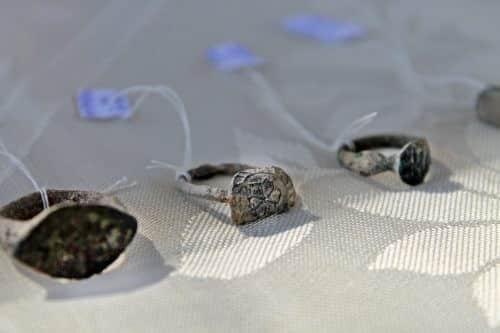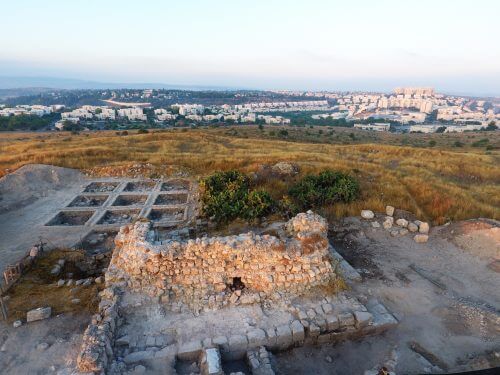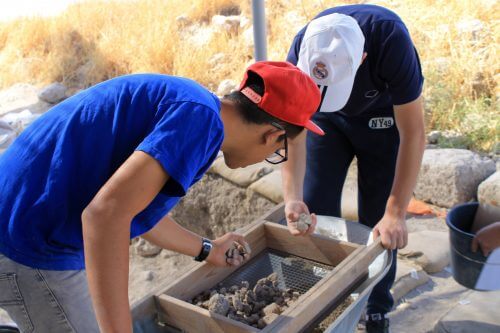A jewel from an excavation: about 2,500 students from schools in Modi'in and volunteers participating in an archaeological dig by the Antiquities Authority in the city uncovered a fascinating discovery: an extraordinary collection of women's jewelry that is about 900 years old. According to the director of the excavation, Avraham Tendler: "It seems that the rings, bracelets and earrings - some of them are bronze and silver, were dropped randomly during cooking in the Migdal Kedom kitchen." Mayor of Modi'in, Haim Bibbs: "In light of the great success, the project will continue next year as well"

How did 900-year-old rings, bracelets, earrings and hairpins end up in the kitchen of a crusader fortress tower in Modi'in? This question may not be asked in the upcoming history test of the city's students, but it certainly preoccupies them during their participation in an archaeological dig near the house. The students - from grades XNUMX-XNUMX, get to reveal fascinating demands for peace from those who once lived here.
The Antiquities Authority, in cooperation with the Municipality of Modi'in-Reot, is conducting an educational and community archaeological dig in Givat Titorah in the city. Every day, a school class comes to dig at the archaeological site, along with pensioners and volunteers who live in the city. The purpose of the excavation is educational and moral: to give the city's residents, of all ages, the opportunity to reveal the cultural heritage of their city, directly and indirectly.
Givat Titorah is a unique and fascinating archaeological site within the city limits of Modi'in-Maccabim-Reot. In archaeological excavations that took place on the hill in the past, evidence of life there from the Chalcolithic period (about 6,000 years ago) until the modern era was discovered. The location of the hill is strategic - on the main road that went up from the coastal plain to Jerusalem, and it is surrounded by fertile valleys that were used for agriculture, and could support the inhabitants of the hill throughout the generations.

According to Avraham Tendler, the director of the excavation on behalf of the Antiquities Authority, "Modiin students and the volunteers reveal the inner courtyard of the Crusader citadel. Here, they cooked and baked for the inhabitants of the citadel for hundreds of years during the Middle Ages - about 900 years ago. In the ancient kitchen, ancient clay ovens (tabuns), cooking pots, jugs, serving and tableware, remains of many foods such as olive skins, legumes, charred grape vines, as well as animal bones are revealed. It seems that the ancient cooks were not careful enough with the jewelry they wore while cooking and baking, because in the excavation there are many jewels, some made of bronze and silver."
Most of the jewels were found by Mati Yohannoff - a volunteer archaeologist who keeps coming to the dig. According to him, "In the entire site we found many metal objects, including coins, rings, bracelets and make-up tools. These findings indicate a nature of activity that is traditionally associated with domestic female activity.' The old residents of the city and other volunteers who come to the excavation, investigate the foundations of the citadel and systematically reveal a large structure from the Roman period, hidden under the crusader citadel.
"I was excited to discover a mixed, cohesive and caring community in the city of Modi'in, says Vared Busiden, the project coordinator on behalf of the Antiquities Authority. "The relationship of the residents to Givat Hatitura is special, and I'm sure it will grow stronger following the archaeological excavation. Enthusiasm begins among the younger generation, in activities delivered by the Antiquities Authority in schools, and makes its way to homes - to parents and the extended family. There, in fact, lie the seeds that will lead to the development of awareness for the preservation of antiquities."

The municipality of Modi'in-Maccabim-Reot is working on establishing an urban nature park on the hill, which will make the site more accessible and closer to the public. This, in the hope that the project will continue over the years, so that the residents of the city can continue to peel back the ancient layers of the mound, explore its treasures, and connect with their past in an experiential and exciting way.
Haim Bibs, mayor of Modi'in Maccabim Re'ot, said that "Givat Hatitura is the symbol of the connection between ancient Modi'in and the glorious history of this region of the country and the city that exists today. There are many historical and archaeological findings on the hill, and I believe that the many travelers who come to it deserve to be exposed to them, alongside enjoying the green and unique corner of the city. We will continue to work in cooperation with all the relevant parties, so that Givat Hatitura will become an urban nature site accessible to everyone and will be a source of learning about the treasures of the area."
See more on the subject on the science website:
